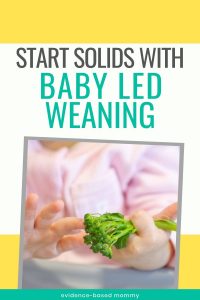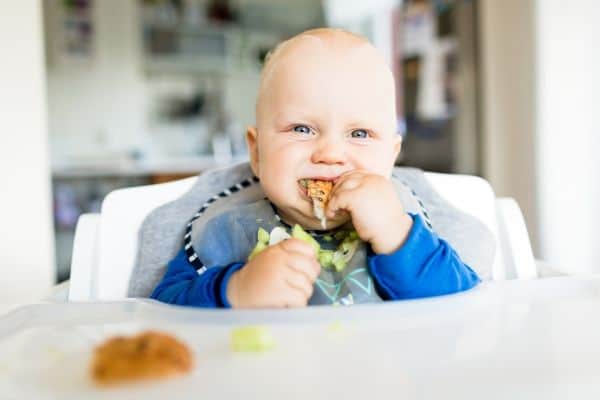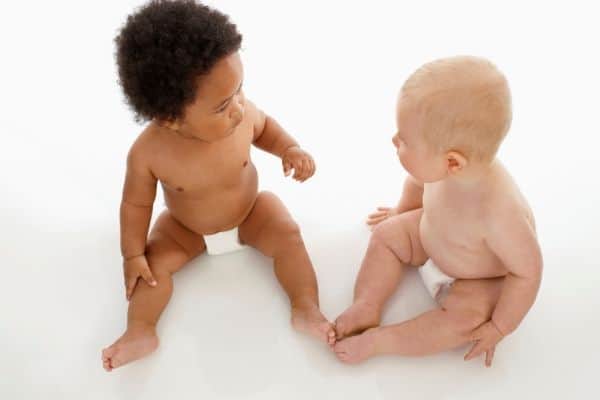Have you ever heard of baby led weaning? If so, you may wonder what’s different about baby led weaning from other ways of feeding your baby.
I heard of baby led weaning soon before my first was born, and it sounded interesting to me. Plus, it’s backed by solid (ha-ha, no pun intended) science.
Since then, I’ve started solids using baby led weaning with all four kids and loved it.
Disclosure: This article contains affiliate links. As an Amazon associate I earn from qualifying purchases. You can read my full policy here.
Read on to learn what baby led weaning is, why it’s more respectful of your baby’s development than the typical path towards solids, and how to do it!
Table of Contents
What is baby led weaning (BLW)?
For those of us in the States, the term baby led weaning may seem misleading.

In the UK (where BLW got its start), weaning isn’t about getting your baby off of breastmilk, it’s simply about introducing solids. Often, baby led weaning starts with little to no reduction of breastmilk or formula as your child (and her gut) is getting used to solids.
The main premise of baby led weaning is that you let your child feed herself solids, instead of you spoon feeding prepared baby food.
Does this sound crazy? Maybe, but it works! When your child is ready, she’ll pick up food, put it in her mouth, and chew it and swallow it. It’s so fun to watch.
For a really in-depth dive into BLW, grab the book by Dr. Gill Rapley!
Advantages of baby led weaning
There are so many reasons to do baby led weaning. These are some of my favorites.
Your baby will start eating when he’s actually ready
There are lots of ideas out there on how to make your baby start solids. And many times, if he doesn’t begin eating “real” food by a certain age, parents will be worried that there’s something wrong.
But usually, there isn’t! Generally, we’re pressured to start solids too early (more on that below). Plus, if your child shows a preference for breastmilk or formula over food, that’s not dangerous. As they say, “Food before one is just for fun.”
Baby is set up with healthy eating habits for life
One of the main problems we have with food is self-regulation. While there’s lots of possible reasons for this issue, one of them may be a simple lack of choice when we started eating.
When you’re feeding a baby yourself, it’s very easy to feel compelled to finish off the little jar of baby food or push “just one more bite” for your baby. Habits like this can lead to overeating as adults.
With baby led weaning, your child is control of how much he does (or doesn’t) eat. This allows your baby to learn to “listen to his tummy” and notice when he’s full.
Plus, baby led weaning often leads to a much broader taste palette. Because you’re not limited to just a few jarred foods with no seasoning, your baby has a better chance to explore foods of different tastes and textures. A lot of times, they’ll eat foods that you’d never expect a baby to show interest in!

And while it’s true that your baby’s food choices are likely to narrow in toddlerhood (sorry, just trying to be honest), the foundation of trying many different foods will set him up to eat a varied diet when he gets older.
RELATED: 6 ways to help your picky kid eat better
Feeding pressure is off parents
On a practical level, one of the best things about baby-led weaning is that the pressure is off of you to get the baby fed. Put food on his tray, let him play, and maybe some of it will end up in his mouth. Instead of having to zoom spoon airplanes into your baby’s mouth, you can enjoy your meal while baby enjoys his.
If your baby doesn’t eat, that’s okay, because milk is still his primary source of nutrition. BLW takes the stress out that your baby “has” to eat solids.
When to start baby led weaning
You should probably start solids later than you expect! For example, there is no need for those rice cereals to add to bottles. Rice cereal is often high in arsenic, has little nutritional value, and doesn’t help your baby sleep through the night (despite what Aunt Sally told you).
RELATED: Dangers of rice cereal for babies
Despite what many pediatricians tell you, the CDC recommends waiting for your baby to be about six months old before giving them anything other than breast milk or formula. In fact, it’s not really about age, it’s about these three factors (taken straight from the CDC):
- Your baby can sit up unsupported (no slumping in a high chair!)
- Your baby has good head and neck control.
- Your baby is acting interested in food.
The main reason for this recommendation is that your baby’s gut lining has not matured enough to properly handle solid foods until six months. You know a good hint for when the gut lining has matured? When your baby can sit unsupported.

In fact, one of the best indications that your baby is really ready for solid food is that she grabs food on her own (maybe even from your plate!), picks it up, puts it in her mouth, and then chews and swallows it.
Best first foods for baby led weaning
There’s lots of great first foods for baby led weaning, but two favorites are banana and avocado. Both of my girls started with banana, and my older son’s first food was avocado. Both of these options are soft, easy to pick up (if a little slippery), and nutrient dense.
Watch my younger daughter eat her very first food – a banana – in this video clip. You’ll see that she manages just fine.
Other great options are roasted winter squash or sweet potato (cut into sticks so one end can be held by a little fist while the other is gnawed on), chopped sautéed spinach (mixed with breast milk if you wish), or very finely diced tender chicken. If you can squish the food between your thumb and finger, it’s soft enough for little toothless gums to chew.
Note: Make sure you still pick soft foods even when (especially when) those first little front teeth come through! You don’t want your little one to accidentally bite off a piece of apple and then not have the molars to chew it. That could lead to choking.
Of course, there’s nothing saying your baby can’t eat mashed foods. After all, mashed is just another texture to explore! Often for adults, we thin out mashed foods with dairy or broth. While (sodium-free) broth or stock is fine for babies, they really aren’t ready for dairy yet.
Instead, use a splash or two of breastmilk. Creamed spinach with breastmilk is a great food for baby to try!
Best spoons for baby led weaning
When you give your baby mashed foods, go ahead and give her a spoon too. But think about the baby spoons you typically see. They really aren’t designed for BLW.
Typically, baby spoons have a long handle. While that’s great for a parent spoon feeding their baby, it’s not as useful for a baby trying to feed herself. Instead, look for spoons with shorter handles, such as these.
Can my baby eat table food?
With a little forethought to reduce the salt in your food (and don’t we all need that anyways?), you can pretty much feed your little one whatever you’re eating. Spaghetti all over the face is a classic.
On nights that we have taco salad, I would give the baby some rice, beans, seasoned ground beef, and avocado and let him try all of it. Herbs and spices (not including salt) are all great for your baby to try, so don’t be afraid of seasoning.
Once your child develops a pincer grasp, between 8-12 months of age, a whole new world of food opens up. Instead of being able to grasp sticks, they’ll be able to hold smaller foods with their thumb and forefinger. Peas, blueberries, Cheerios, and grape halves will become options.
NOTE: It’s very important to cut grapes in half so they don’t get caught in the airway and lead to choking.
Will babies choke with baby led weaning?
One thing to be aware of: When you first see a baby trying baby led weaning, it may look like the child is choking sometimes. He’s not! If his gag reflex kicks in, that’s actually a good thing that protects your child. Don’t stick your finger in and try to fish the food out. You’re more likely to accidentally push the food back further in his throat, causing choking, than to actually remove it this way.
Your child may put a food in his mouth, squish it around for a little while, then spit it back out. That’s okay. As they say, food before one is just for fun. Your baby is still getting plenty of nutrition from the breastmilk and/or formula he’s getting from you.
Can you use purees alongside baby led weaning?
Remember, make baby led weaning work for you, not the other way around. If you need a quick chance to feed your child but you don’t have any suitable adult food on hand, a pouch or jar of food is fine (and you can still let your kids feed themselves with a spoon if you want)
Conclusions on baby led weaning
I hope this post gives you an idea of the possibilities there are surrounding introducing your baby to solid foods. A fantastic resource detailing what to expect using this feeding method is a book called Baby Led Weaning.



With thanks! Valuable information!
I’ve been looking for info on how to start solids. Thanks!
You’re so welcome!
Chicken Tikka Masala is creamy, packed full of flavour and perfect as a baby led weaning dinner recipe. The best part is babies love it and while you may not think a curry is a good recipe for a 6 month old baby, I promise it is amazing! Curry is a great way to introduce aromatic spices, not spicy hot ones, but spices like cumin, coriander and turmeric.
Hi Marlie,
I agree! I’ve totally given curry to my baby and he loved it.
hi! my wife and i are considering BLW, but haven’t had much luck finding any scientific evidence (just google searching) to support the approach. you mentioned that BLW is backed by solid science; do you think you could share some sources? thank you!
Hi Evan,
There’s not a ton out there, but this and this might be helpful. Thanks for reaching out!